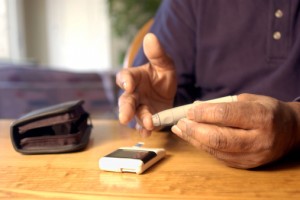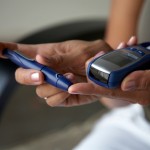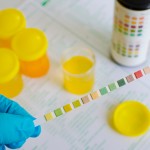Home test to check if you have diabetes
 Testing blood sugar at home can be an effective way to treat and monitor your diabetes. Diabetes is one of the top 10 causes of death in North America. About 29.1 million people in the U.S. have diabetes – 8.1 million cases are undiagnosed.
Testing blood sugar at home can be an effective way to treat and monitor your diabetes. Diabetes is one of the top 10 causes of death in North America. About 29.1 million people in the U.S. have diabetes – 8.1 million cases are undiagnosed.
Suspecting that you or a loved one might have diabetes can be scary. It is a condition that causes sweeping changes to a person’s lifestyle. In most cases, because the early signs of diabetes are not known, being diagnosed comes as a shock. However, there are affordable tests that can be done at home to help diagnose diabetes in its early stages.
But before you embark on home testing, it’s important to recognize the symptoms that can help you determine if home testing is necessary. Major symptoms of type 2 diabetes include:
- Excessive thirst
- Frequent urination
- Excessive hunger
- Fatigue
- Blurry vision
- Sores and cuts that won’t heal
What are diabetic home tests?
 Although going in to see your doctor will give you accurate blood sugar readings, it can be a hassle making an appointment, waiting to see your doctor and traveling to and from the office. Instead you can do at home testing, which can help you better monitor and control your diabetes.
Although going in to see your doctor will give you accurate blood sugar readings, it can be a hassle making an appointment, waiting to see your doctor and traveling to and from the office. Instead you can do at home testing, which can help you better monitor and control your diabetes.
There are different types of at-home tests you can complete daily to properly monitor your blood sugar levels. You can do a blood test, urine test or use an A1C kit.
Those who would benefit from diabetic home testing are those with type 1 diabetes, type 2 diabetes, prediabetes and individuals who are showing signs of diabetes. By keeping track of blood sugar levels you can gauge how your current treatment and lifestyle habits are affecting your condition.
A normal blood sugar reading, according to the Centers for Disease Control and Prevention (CDC), is between 70 and 140 mg/dL. Low blood sugar, or hypoglycemia is considered when a reading is below 70 mg/dL and hyperglycemia, or high blood sugar is a reading over 140 mg/dL.
Maintaining healthy blood sugar levels not only helps control or prevent diabetes, but it reduces your risk of developing diabetic complications like diabetic coma, eye disease, gum disease, kidney disease and nerve damage.
Tips for accurate home testing
 A blood glucose test is the most common form of at-home diabetes testing. It involves a small needle known as a lancet, a device to hold the needle, test strips, a glucose meter and sometimes it will come with a cord to download the data to a personal computer device.
A blood glucose test is the most common form of at-home diabetes testing. It involves a small needle known as a lancet, a device to hold the needle, test strips, a glucose meter and sometimes it will come with a cord to download the data to a personal computer device.
When completing a blood test to check blood sugar, ensure you start with clean hands and a new needle. Load up the lancet device with the needle and place the test strip in the glucose meter. Prick your finger with the needle and place the drop of blood on the test strip. When this step is completed the glucose meter will display the results. If you have any questions or concerned about your home blood testing device consult, read the instructions for the device or speak with your pharmacist or doctor who can better show you how to use it.
There are other tips to keep in mind to make sure you always get an accurate reading. For starters, always ensure you are using the correct test strip for the device. Many devices require a particular strip, so if you attempt to use a different one, the reading may be off. Also, it’s advised you use your finger to prick. Although some devices allow for blood to be drawn from the arm or leg, always check the device’s instructions or with your doctor prior to trying it that way.
Additionally, the CDC recommends that for accurate results you should test insulin between two to four times a day. You may choose to test before and after a meal to see how your blood sugar is affected by food. It’s also important to test blood sugar after consuming simple carbohydrates or sugary foods to ensure your blood sugar is not too high.
Keeping track of your results can also help with accuracy. As mentioned, some devices come with a cable that allows you to upload the data, but with others you may simply have to document the results by hand. Important information to document when checking glucose:
- Time and date of the test
- Any medication and dosage you are taking
- Whether you took the test before or after a meal
- Foods you ate if taken after a meal
- Any workouts you completed and when they were done
Tests to determine the stage of diabetes
As mentioned, there are three different at-home tests you can perform to determine diabetes. Below is how each tests works, and how it can help you determine which stage your diabetes has reached.
 At home diabetic test: Urine test
At home diabetic test: Urine test
A less invasive method for testing blood sugar is through urine glucose test strips. These strips should only be used to determine if high blood sugar is present. The strips do not read a blood sugar lower than 180 mg/dl and they are very easy to misinterpret. If glucose shows up on the urine test strips, it is important to test your blood sugar level using a blood sugar meter for a more accurate reading.
At home diabetic test: Blood test
The easiest and most accurate at home test for diabetes is a blood sugar test. Blood sugar meters usually come with a small amount of test strips, as well as a lancing device. It is important to follow the directions included with the meter. Also, before testing your blood sugar, it is important to wash your hands first to eliminate any sugar residue, which could alter the readings. Normal fasting blood sugar should be between 70-130 mg/dl. If testing within two hours of eating, then the results should be less than 180 mg/dl.
At home diabetic test: A1C kits
Another method to test for diabetes at home is the At Home A1C kit. These kits test the hemoglobin A1C and give a three-month average of your blood sugar. A normal A1C should be under 5.7%. When purchasing an at-home A1C kit, make sure that it offers results within five minutes. Some of the at-home kits require sending a blood sample to a lab and waiting for three to six weeks for the results.
If any of the tests above show presence of glucose or a high sugar level that falls in the diabetic range, it is time to consult a doctor. But if your test results show you are negative for diabetes or if you have pre-diabetes, you can take steps to reduce your risk of the disease by:
- Losing weight. Research shows that reducing your body weight by five to 10 percent – 10 to 20 pounds for someone who weighs 200 pounds – can cut your risk of type 2 diabetes in half.
- Eating right. Your diet should be rich in vegetables, fruits, whole grains, low-fat dairy and lean protein sources. Limit foods high in saturated and trans-fats, cholesterol, sodium and added sugars.
- Exercising regularly. Work up to at least 30 minutes of exercise most days of the week. Always check with your doctor before you increase your activity.
Early insulin treatment for diabetes produces better outcomes: Study
Researchers have found that early insulin treatment for diabetes is as effective as 15 months of oral treatment when it comes to improving the body’s ability to produce insulin. The research was conducted on 23 adults who were newly diagnosed with type 2 diabetes. Continue reading…
-
Tone Up Your Muscle Tissue And Increase Your Fat Burning Potential
We see many advertisements these days fo
-
Does The Slim Fast Diet Work?
Losing weight is a matter of burning more calories than you eat. Tha
-
Check Your Sweet Tooth - The Sugar Obesity Connection
In an attempt to eat healthier and lose weight many people have giv
-
Cashews: Handful (or two) a day keeps the doctor away
Nuts are certainly having a moment! All the enthusiasm comes fr
-
Natural Weight Loss - Balance Your Thyroid
Discovering how to balance your thyroid gland hormones can help you
-
The Top 6 Most Effective Advice To Grow Taller
When we look good, we also feel good. But if we dont feel confident, w
- DON'T MISS
- Weight Loss And How To Lose Weight Fast
- Lennox Z Lockers
- Lifestyle Intervention Programs - Reduce Risk Of Diabetes
- Achieving A More Youthful Figure With A Tummy Tuck And Liposuction Of The Iliac Areas
- Fight Hunger With a High Protein Diet - What You Should Know
- 21 Ways to Reward Yourself Without Food
- Transform Your Yoga Practice (And Your Body!) With Sprints
- Boot Camp: The Best Fitness Program For Kids
- Underactive Thyroid Symptoms and Remedies
- Welcome to the Weight Loss Resolution




